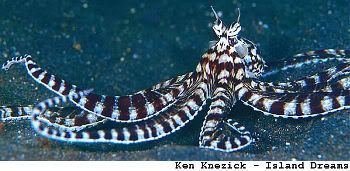Mimic Octopuses: Will we love them to death?
By Dr. Roy Caldwell and Christopher D Shaw - Dr. James B. Wood, Editor
By Dr. Roy Caldwell and Christopher D Shaw - Dr. James B. Wood, Editor
There is no question that the mimic octopus and its relatives such as wunderpus are remarkable animals. Whether they are capable of the repertoire of behaviors attributed to them remains to be seen. Even if their mimetic abilities are limited, we must marvel at the images of these animals that have been captured on film and video and are displayed around the world. However, as the animals become better known, they are also becoming more desirable for public aquarists, scientists and hobbyists alike. The pressures to acquire and attempt to keep and display them are rapidly increasing. It is not uncommon to see requests for such animals and often the amount of money offered for them is staggering - $100 and up. At this point, I think we should all take a deep breath and think seriously about the biology of this species, what such bounties are likely to mean for its survival, and what motivates us to want a mimic for our very own. I want to make it clear from the onset that I am not against the importation of marine life where its collection did not threaten existing stocks. I certainly support efforts to culture a variety of organisms for public, commercial and private display. Over the years I have strongly supported the aquarium industry because I firmly believe that public awareness of, and interest in, marine diversity offers one of our best routes to marine conservation. However, I feel strongly that because of its notoriety and scarcity, mimics present a special case that deserves our immediate attention. If there is one thing that we know about mimics, it is that they are rare. Since they were first recognized, very few have been collected or observed in the wild. Even in areas such as the Lembeh Straits and Bali, which have been extensively dived by knowledgeable naturalists, sightings have been infrequent and sporadic. Only dozens have been seen, not hundreds or thousands. Yes, it is a big ocean. However, the habitats apparently suitable for the mimic are limited, easily accessible and the number of people (including collectors) diving on them is rapidly increasing. In a few areas, individual mimics are occasionally identified by underwater guides who take divers to see them. Much of what we know of these animals comes from such sightings. With the bounties being offered for these animals, it is increasingly likely that some collectors who know the whereabouts of mimics will be unable to resist the temptation and these animals will end up in the collection bucket. You do not want to know the fate of most cephalopods collected in Indonesia for export. By offering importers high prices for mimics, I am deeply concerned that we are creating a market that rapidly will exhaust the supply.

I would urge everyone, amateurs and professionals alike, to curtail your desire to display these animals. I hope that with our help they can continue to survive in the wild where they can be studied, photographed and appreciated. These animals have enough problems without our hastening their doom. The coastal habitats in which they occur are some of the most heavily impacted in Indonesia. Coastal run off and mining are eliminating them at an alarming rate. To my mind, risking several of these rare beasts so that one might live for a few months (with no hope of successfully reproducing) in an aquarium just is not worth the price. It would be great if we could acquired a sufficient number of specimens to keep them in aquaria around the world, learn their habits and how to culture them, etc. I would strongly support this for a species like O. cyanea that is widely distributed. However, there does not appear to be the population base needed to support intense collection of mimics. With modern communications, mimics are popping up everywhere in print, on television and on the web. People around the world know about mimics and want one. The market isn't just in the US, Germany, and Japan, but extends around the world. How many public aquaria would like to exhibit one? How many scientists, myself included, would dearly love to have a few to study? How many amateur cephalopod enthusiasts would shell out big bucks to have one? And how many hobbyists walking into their local LFS would put down their money just because the mimic looks so cool? By promoting this exceptional animal I'm afraid that we have created a demand that may do it in. Sure, a few specimens were needed to document the species and the occasional animal will make its way into the market place. Stuff happens and I cannot fault anyone for taking advantage of it. All I'm asking is that we do everything in our power not to encourage or support the deliberate collection of mimics. I honestly fear that if we cannot stem their collection, there will be no mimics to wonder at in a very few years...
El artículo puede leerse completamente en The Cephalopodo Page.
Labels: Características



0 Responses to “Mimic Octopuses”
Leave a Reply